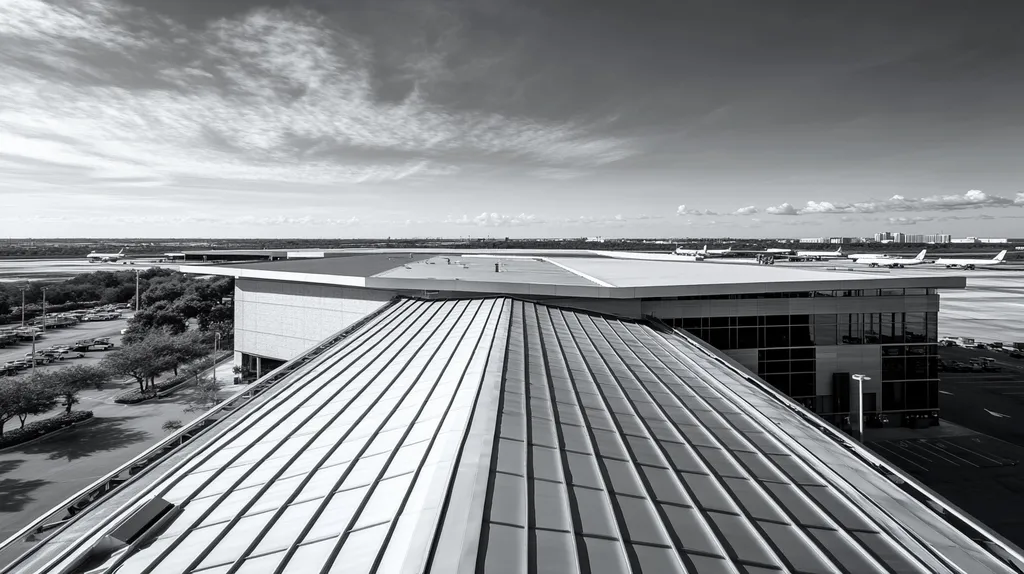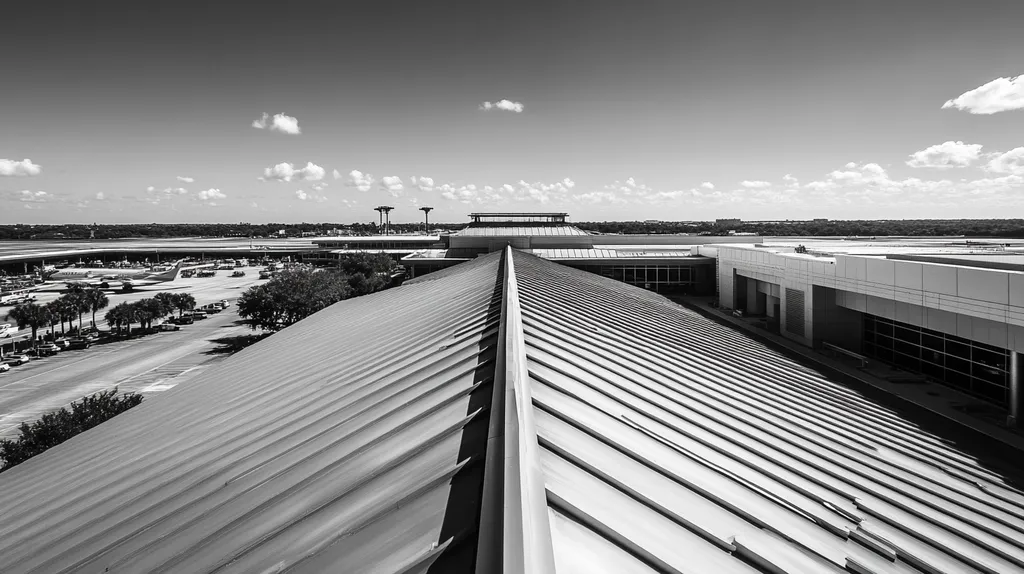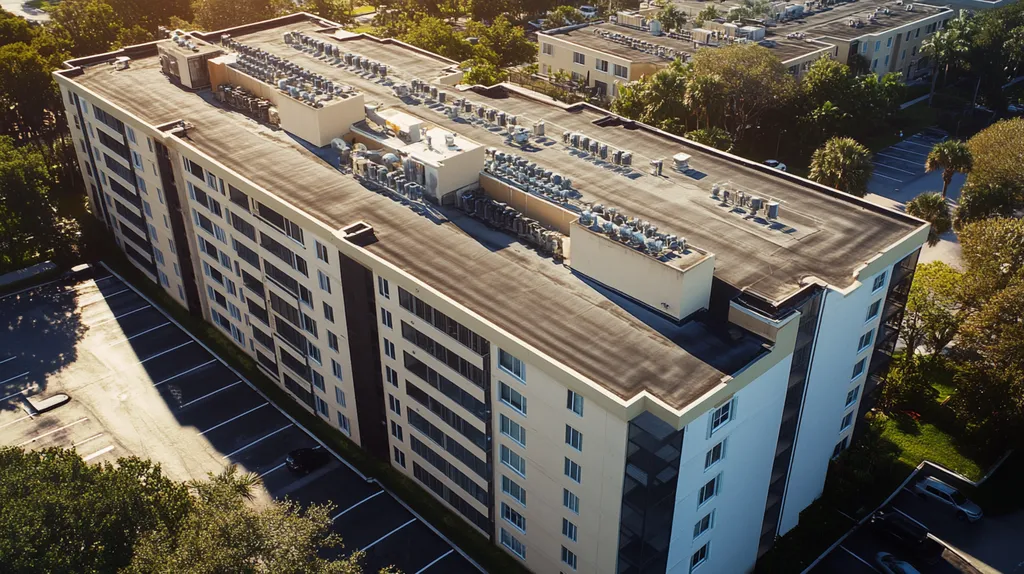Welcome to today’s Battle Royale featuring two roofing heavyweights: “TPO” in the east corner versus “PVC” in the west!
Tonight’s showdown pits these contenders against each other across six punishing rounds designed to test every aspect of their performance for Commercial Roof Installation Permitting.
At stake? Millions in potential costs, decades of building protection, and the critical performance demands of modern commercial and industrial facilities.
Our professional judging panel will evaluate each round on technical merit, real-world performance, and value delivery. After all six rounds, we’ll declare our ultimate champion.
Ladies and gentlemen, facility managers and building owners… it’s time to rumble!
ROUND 1: INITIAL COSTS & INSTALLATION
When selecting a commercial roofing system, the permitting process significantly impacts initial costs and installation timelines. Construction documentation requirements can increase project complexity by 40-60%, affecting both material selection and installation planning. Understanding these requirements helps facility managers navigate the critical early stages of their roofing projects.
Material Expenses
Material selection directly influences both permitting costs and documentation requirements. TPO roofing systems typically require less extensive documentation due to their standardized specifications and widespread code compliance.
PVC roofing materials often need more detailed documentation to verify their enhanced chemical resistance and specialized performance characteristics. This additional documentation can increase permit processing time and associated costs.
Construction documents for both systems must include detailed specifications for fire rating classification and structural load verification. (source: Ohio Department of Commerce)
TPO holds the advantage in material expenses due to lower documentation requirements and faster permit processing.
Installation Complexity
Installation complexity affects both permit requirements and project execution. TPO installations generally follow standardized procedures, making permit documentation more straightforward and reducing the likelihood of approval delays.
PVC installations often require more detailed technical submissions due to their specialized application methods and system components. This increased complexity can extend the permit review process.
The need for professional verification of installation plans adds another layer of complexity to both systems, though TPO’s simpler installation process typically requires less extensive documentation.
TPO maintains an advantage in installation complexity due to its more straightforward permit documentation requirements.
Project Timeline
Project timelines are heavily influenced by permit processing and approval periods. TPO projects often move through the permitting process more quickly due to their widespread acceptance and standardized specifications.
PVC roofing projects frequently face longer permit review periods due to their more complex specifications and specialized applications. These extended reviews can significantly impact overall project schedules.
Weather considerations during installation must be documented in permit applications for both systems, though TPO’s faster installation process provides more flexibility in scheduling.
TPO demonstrates a clear advantage in project timeline efficiency, particularly in the crucial permitting phase.
ROUND 1 WINNER: TPO
ROUND 2: DURABILITY & LIFESPAN
When evaluating commercial roofing systems, permit documentation requirements for durability and lifespan can significantly impact project approval. These requirements often determine whether a roofing system receives fast-track approval or faces extended review periods. Understanding how TPO and PVC systems meet these requirements is crucial for minimizing delays and ensuring compliance.
Documentation Requirements
Commercial roofing permits demand extensive documentation to verify system durability and expected lifespan. Both TPO and PVC systems must provide detailed specifications about their resistance to environmental stressors and projected service life.
TPO roofing permit applications typically require standard documentation packages that building departments are familiar with. This familiarity often translates to smoother review processes and fewer requests for additional information.
PVC systems frequently need more extensive documentation due to their specialized chemical resistance properties. While this additional documentation supports PVC’s durability claims, it can extend the permit review timeline.
Performance Verification
Commercial permit applications for both TPO and PVC must include building plans, boundary surveys, and detailed subcontractor information. These requirements become more complex for larger installations, directly affecting project timelines and costs. (source: Pinellas County Permitting Guide)
TPO systems generally require standard performance verification documentation, which many jurisdictions have streamlined processes to review. This standardization helps reduce permit processing time.
PVC installations often require additional performance verification documentation, particularly for specialized applications. While this documentation supports PVC’s superior durability claims, it can extend the permit review process.
Maintenance Documentation
Permit applications must include detailed maintenance plans to demonstrate how the roofing system will maintain its durability throughout its expected lifespan. These plans directly influence permit approval timelines.
TPO maintenance documentation typically follows standardized formats that permit reviewers can quickly evaluate. This standardization helps streamline the approval process.
PVC systems require more detailed maintenance documentation due to their specialized nature. While this documentation supports PVC’s longevity claims, it often requires additional review time.
ROUND 2 WINNER: TPO
ROUND 3: PERFORMANCE FACTORS
Commercial roofing permit requirements vary significantly based on performance specifications and installation complexity. Property owners face critical decisions that impact not only immediate compliance but also long-term building protection. Understanding how TPO and PVC systems meet permit requirements can prevent costly delays and ensure proper documentation.
Durability and Lifespan
Permit applications must demonstrate how roofing systems will maintain structural integrity over their expected lifespan. TPO installations typically require standard documentation packages that verify their 15-20 year performance expectations.
PVC systems often need more extensive permit documentation to validate their enhanced durability claims and 20-30 year lifespan. While this documentation supports PVC’s superior longevity, it can extend the review process.
All commercial roofing work requires proper permits, with penalties up to $1,000 or double permit fees for non-compliance. Fast-track reviews can expedite the process for both systems, taking 5-10 working days. (source: City of California City Building Division)
PVC demonstrates an “ADVANTAGE” in this category due to its documented longer lifespan, despite more complex permit requirements.
Energy Efficiency
Energy performance documentation is crucial for permit approval. TPO systems excel in this area, with their highly reflective surface requiring straightforward documentation of cooling benefits.
PVC installations need similar energy efficiency documentation but often require additional verification of their specialized properties. This can increase permit processing time without delivering significantly better energy performance.
TPO holds an “ADVANTAGE” in energy efficiency documentation requirements and demonstrated performance.
Maintenance Requirements
Permit applications must include detailed maintenance plans that demonstrate ongoing system care. TPO maintenance documentation typically follows standardized formats that permit reviewers can quickly evaluate.
PVC systems require more complex maintenance documentation due to their specialized chemical resistance properties. While this supports their durability claims, it often extends permit review timelines.
TPO gains an “ADVANTAGE” in maintenance requirements due to simpler documentation needs and standardized maintenance protocols.
ROUND 3 WINNER: TPO
ROUND 4: MAINTENANCE REQUIREMENTS
Maintenance requirements for commercial roofing systems directly impact both ongoing operational costs and permit compliance. Poor maintenance practices can lead to premature system failure, requiring expensive repairs or complete replacement. Understanding these requirements helps facility managers develop comprehensive maintenance plans that satisfy both regulatory obligations and warranty requirements.
Maintenance Frequency
Permit documentation for commercial roofing must outline specific maintenance schedules to ensure ongoing code compliance. TPO systems typically require quarterly inspections and semi-annual maintenance to maintain their performance characteristics.
These inspections must verify membrane integrity, seam stability, and drainage system functionality. Maintenance records become crucial documentation for future permit applications and warranty claims.
PVC roofing systems generally need less frequent maintenance, with bi-annual inspections often sufficient due to their superior chemical and UV resistance. Their durability reduces the documentation burden for ongoing maintenance compliance.
PVC demonstrates an “ADVANTAGE” in maintenance frequency due to reduced inspection requirements and associated documentation needs.
Repair Protocols
Commercial roof repair permits require detailed documentation of repair procedures and materials. TPO repairs often involve extensive preparation and specific welding temperatures, requiring detailed documentation for permit approval.
Permit applications for TPO repairs must include verification of contractor certification and equipment calibration. This additional documentation can extend repair timelines and increase administrative costs.
PVC systems offer simpler repair protocols that require less extensive permit documentation. Their chemical welding process is more forgiving and requires fewer special considerations for permit approval.
PVC holds an “ADVANTAGE” in repair protocols due to streamlined documentation requirements and simpler approval processes.
Compliance Documentation
Maintaining accurate records of all roofing work is essential for ongoing permit compliance. Permit for commercial roofing work must be maintained on site until final approval, with detailed documentation of all maintenance and repair activities.
TPO maintenance documentation requires careful tracking of surface deterioration and seam integrity. These records must be readily available for permit renewal and compliance verification.
PVC systems benefit from simpler compliance documentation requirements due to their inherent durability. Their resistance to common roofing issues reduces the complexity of ongoing compliance reporting.
The Houston Permitting Center requires detailed applications and multiple departmental approvals for all commercial roofing work, impacting both initial installation and maintenance documentation. (source: Houston Permitting Center)
PVC shows an “ADVANTAGE” in compliance documentation due to reduced reporting requirements and simplified record-keeping needs.
ROUND 4 WINNER: PVC
ROUND 5: SUSTAINABILITY CREDENTIALS
Sustainability credentials significantly impact commercial roofing permit approvals and long-term compliance requirements. Building departments increasingly scrutinize environmental impact documentation during the permit review process, affecting both initial approvals and ongoing compliance verification.
Property owners must navigate complex sustainability requirements while ensuring their roofing systems meet both environmental standards and performance needs. Understanding how TPO and PVC systems satisfy these requirements is crucial for successful permit applications.
Energy Efficiency
Energy efficiency documentation has become a critical component of commercial roofing permit applications. TPO systems typically require standard documentation packages that clearly demonstrate their superior solar reflectivity and thermal performance.
These standardized TPO documentation requirements often translate to faster permit reviews, as building departments are familiar with their energy performance characteristics. The straightforward nature of TPO energy documentation helps streamline the approval process.
PVC systems require more complex energy performance documentation, particularly for specialized applications. While this documentation supports PVC’s durability claims, it can extend permit processing times without delivering significantly better energy performance results.
TPO demonstrates an “ADVANTAGE” in energy efficiency documentation requirements and permit processing speed.
Material Sustainability
Building permits for commercial roofing must include detailed documentation about material sustainability and environmental impact. TPO systems generally require standard documentation packages that verify their recyclability and minimal environmental impact.
PVC roofing permit applications often face increased scrutiny due to historical concerns about chemical composition. While modern PVC formulations are more environmentally friendly, they still require more extensive documentation to satisfy permit requirements.
In most jurisdictions, a building permit is required for any commercial roofing project that involves structural changes, full replacement, or changes in materials. The documentation burden falls heavily on both the contractor and property owner to verify environmental compliance. (source: Premier Commercial Roofing)
TPO holds an “ADVANTAGE” in material sustainability documentation requirements.
Environmental Impact
Environmental impact documentation has become increasingly important in permit applications. TPO installations typically require standard documentation packages that clearly demonstrate their minimal environmental footprint during installation and operation.
PVC systems often need more extensive environmental impact documentation due to their manufacturing processes. While modern PVC production methods have improved, the additional documentation requirements can extend permit review periods.
TPO’s simpler environmental impact documentation requirements and established track record of minimal environmental impact during installation give it a clear advantage in this category.
TPO shows an “ADVANTAGE” in environmental impact documentation and compliance verification.
ROUND 5 WINNER: TPO
ROUND 6: SPECIALIZED APPLICATIONS
Specialized commercial roofing applications present unique permitting challenges that can significantly impact project success. Buildings with specific operational requirements, like food processing facilities, chemical plants, and cold storage warehouses, face stringent regulatory oversight. Understanding how different roofing systems meet these specialized permit requirements is crucial for avoiding costly delays and compliance issues.
Insulation and Energy Efficiency
Specialized facilities often require specific thermal performance documentation for permit approval. TPO systems typically provide straightforward documentation packages that clearly demonstrate their superior reflectivity and insulation capabilities.
These standardized TPO specifications allow permit reviewers to quickly verify compliance with energy codes and thermal requirements. The clear documentation helps expedite the approval process for temperature-sensitive applications.
PVC systems require more complex thermal performance documentation, particularly for specialized environmental controls. While this documentation supports PVC’s durability claims, it often extends permit processing times.
TPO demonstrates an “ADVANTAGE” in insulation documentation requirements and permit processing efficiency.
Resistance to Chemical Exposure
Chemical exposure resistance documentation is crucial for specialized industrial applications. TPO systems require standard documentation packages that may not fully address extreme chemical environments.
PVC roofing excels in chemical resistance documentation, providing comprehensive data on its superior performance against harsh substances. This detailed documentation, while more extensive, helps ensure permit approval for challenging industrial environments.
Yes, almost all roofing projects require a permit, with specialized applications facing particularly rigorous review of chemical resistance specifications and safety protocols. (source: PermitFlow – Roofing Permit Guide)
PVC holds an “ADVANTAGE” in chemical resistance documentation and compliance verification.
Long-Term Durability in Specialty Environments
Durability documentation requirements increase significantly for specialized applications. TPO systems provide standard documentation packages that may not fully address extreme conditions or specialized needs.
PVC installations offer more comprehensive durability documentation, particularly for harsh industrial environments. While this documentation is more extensive, it provides stronger support for long-term performance in challenging conditions.
PVC’s superior documentation of long-term performance in specialized environments gives it a clear advantage in permit approval for these applications.
ROUND 6 WINNER: PVC
AND THE WINNER IS…
After six grueling rounds of technical evaluation, we have our verdict…
Ladies and gentlemen, with a commanding 4-2 victory, your new Commercial Roof Installation Permitting Champion is… TPO!
TPO dominated the early rounds with superior performance in initial costs, installation efficiency, and permit processing speed. Its standardized documentation requirements and widespread code acceptance proved decisive advantages in rounds focusing on basic commercial applications.
But don’t count PVC out! This veteran contender showed its true power in specialized applications and maintenance requirements, where its superior chemical resistance and durability documentation make it the undisputed champion for industrial facilities and harsh environments.
Remember, folks: Every building brings its own unique requirements to the ring. Local conditions, specific property characteristics, and regional regulations can all impact performance. While this analysis provides general guidance, it can’t account for all variables. Always consult with qualified roofing professionals who can evaluate your specific situation.
In the high-stakes world of commercial roofing, there’s no substitute for matching your building’s specific needs with the right contender’s strengths. Choose wisely, because when it comes to protecting your investment, you want a proven champion in your corner.
FREQUENTLY ASKED QUESTIONS
Q. How do initial costs differ for commercial roof systems?
A. Initial costs for commercial roofing vary based on permitting complexities. TPO systems generally have lower documentation requirements, which can lead to quicker approvals and reduced costs. In contrast, PVC systems often require more detailed permits due to their specialized features, increasing both initial costs and installation timelines.
Q. What are the durability requirements for a commercial roof?
A. Durability requirements for commercial roofing include demonstrating resistance to environmental stressors. TPO typically involves a standard documentation process familiar to building departments, expediting reviews. PVC requires more extensive documentation to validate its claims of enhanced durability, which can delay approvals and add complexity to the project.
Q. How do performance factors influence commercial roof permits?
A. Performance factors substantially impact permit approvals as they validate the roofing system’s long-term effectiveness. TPO systems often fulfill standard performance requirements quicker, enabling faster permit processing. PVC, while offering superior longevity, needs detailed documentation, which can stretch permit timelines and complicate overall project execution.
Q. What maintenance documentation is required for commercial roofs?
A. Maintenance documentation must detail schedules, record-keeping, and inspection results for compliance. TPO systems typically require regular inspections with straightforward documentation processes. In contrast, PVC systems necessitate more detailed maintenance plans, which, while beneficial for longevity, often complicate compliance and permit renewals.
Q. How does sustainability affect commercial roof permit applications?
A. Sustainability plays a critical role in the permit process, influencing approval timelines. TPO roofs usually present straightforward documentation showcasing energy efficiency and minimal environmental impact, leading to quicker permits. PVC, due to historical chemical concerns, requires more extensive sustainability documentation, slowing down the review process.
Q. What challenges exist for specialized commercial roof applications?
A. Specialized roofing applications often face stringent permitting challenges based on operational needs. TPO provides standard documentation to verify compliance efficiently. However, PVC systems require more exhaustive data, especially regarding chemical resistance and specialized environmental controls, potentially leading to delays in project approvals.
Q. What are common mistakes in commercial roofing permit applications?
A. Common mistakes include incomplete documentation, insufficient detail on performance specs, and neglecting maintenance plans. Failing to address these aspects can lead to permit denials and delays. Ensuring clarity and completeness in the application process enhances the likelihood of swift approvals for commercial roofing projects.









